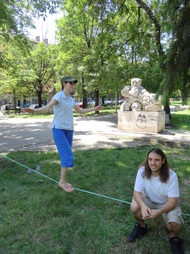
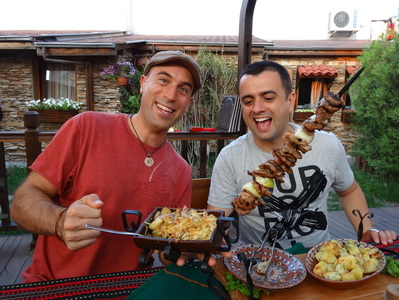
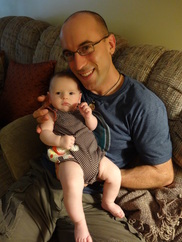
To see the pics of our first days in the States, click here:
 23 months of travel. Countless pillows. Innumberable tables where we sat to write this blog. We have moved around so much and yet for me I have discovered a 2nd home in Bulgaria. Our last week in the country was hard as we met up with the great friends and family that we have been able to reconnect with while in Bulgaria. We had dinners with Neda’s cousin Gosho and his girlfriend Raya, slacklining in the park with our friends Joanna & Morgan, who we met in Thailand, and celebratory drinks with Neda’s old friend Kaloyan, who along with partner Rumiana, were celebrating the birth of their first child. And even as we raised our glass in cheers, there was sadness as our family had just visited Neda’s grandma Marika, who was lying in bed close to death.  How do we reconcile the closeness we feel for this place with our decision to leave? I tell myself that finally it’s time to go home, but I am no longer certain where home is. Zen teaches us that home is a construct that we are constantly destroying and re-creating to find stability in this changing world. And while that abstraction may lend some comfort, it doesn’t feel any better to know it will be too long before we see all of our friends and family in Bulgaria again. Our last dinner in Bulgaria was with Neda’s oldest friend Petya and Dimitar, another old friend from high school. As we caught up on our lives eating delicious Bulgarian cuisine and speaking completely in Bulgarian, I couldn’t help but feel that life here was just beginning even as we were preparing to leave. But how do we choose to whom to say goodbye and to whom to say hello? My Mom gave us a thrilled hug when she saw us walk through the terminal doors and it was wonderful to see her after so long. Yet as we drove back to Lansdale Neda called her parents to find out that Baba Marika had indeed died the day after we had seen her. We had made it to one hello and missed another goodbye.  As if it were the universe’s cosmic plan to remind us of this crazy cycle of birth and death, as Neda hung up with her parents with tears in her eyes we were only a few minutes away from my sister’s house. Sam and her husband Gary were waiting outside in the driveway, with a little bundle of joy in their hands, their new daughter and our new niece, Miranda Hope Koellhoffer. When I looked into her sweet eyes and heard her gentle cooing, the miles we had traveled melted away and I immediately noticed that familiar feeling already starting…here with this baby in my arms, I was beginning once again to create home. It’s probably healthy to let go of our attachments and go through these changes in life in order to keep ourselves from growing stagnant. But I already miss my family and friends in Bulgaria, I miss talking in Bulgarian to little Marilenka, playing backgammon with my father-in-law, and discussing the nuances of Bulgarian language with my mother-in-law. I miss tomatoes whose flavor nearly knocks me unconscious and the view of the Bulgarian countryside when I run atop the hills bordering our neighborhood. But I don’t miss not being able to be a part of my nieces’ lives. My other niece Ella is over 2 years old now and chatting up a storm. She already called us Uncle Jeff & Aunt Neda as she carefully made sure we had enough ice in our water at dinner. And so it goes…to say hello we have to say goodbye. I never expected to feel so much a stranger in my own country. The accents sound strange, the lawns seem so big, and the clothes and bodies look so different (sorry America, but our bodies tend to be quite a bit bigger than everywhere else in the world!). I feel blessed to be given even the smallest glimpse of what it must have been like for Neda and her family when they came from Bulgaria to America 15 years ago. At that time they became a part of two worlds, a family with two homes. And now, in some small way, I’ve joined them. To see all the pics of our last days in Bulgaria, click here: To see the pics of our first days in the States, click here:
3 Comments
Whether you are preparing for a globe-hopping trip or just a two week stint in a foreign land, having the right travel gear can be the difference between stress and relaxation. We did lots of research before our trip and also got some great advice from travelers along the way. Now we want to share with you the most useful gear we used for traveling the world, especially when you want to keep things light and cheap. In Part 1, we’ll focus on gear that keeps your money safe, perhaps the number one concern for a traveler. Of course, the bag you bring might be the most important aspect of your travel gear, but we covered that in our last post on How to Fly Around the World Without Ever Checking a Bag. Wallet I admit that I’m a pretty picky wallet guy. I don’t like anything too bulky but I do like lots of areas for storage. I guess I like to have my cake and eat it too. With the Pacsafe WalletSafe 100, I was able to do just that. This tough nylon wallet’s main security feature is a metal chain that connects to the belt loop of your pants via a secure hooking mechanism. It comes on/off easily and allowed me to be much more relaxed walking through cities. No pickpocket could get this wallet without clearly alerting me to the attempt. It is easy to clean and has enough pockets for many credit cards as well as a nifty little zip pocket for change that I used all the time. Also, if you don’t want to use the chain, there is a velcro pocket to store it in. Since I always use it, that velcro pocket comes in handy for random little things you want to keep safe, like a key for instance. An important note about wallets – I only ever kept a bit of cash, one credit card, and one ATM card in the wallet – everything else went in the security pouch (see below). Security Pouch 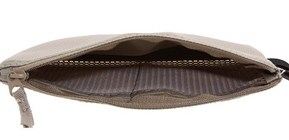 Even with a secure wallet, there are still some things you don’t want to leave within reach of a possible pickpocket attempt. Things like your back-up cash & credit card, passports, and maybe the keys to your travel locks. When I traveled around Europe ten years ago, I used a security pouch that hung around my neck. But stuffed with passports it was visible through my shirt and also was pretty obvious when taken out. For this round, I bought an Eagle Creek Hidden Pocket, and it worked wonderfully. The hidden pocket attaches to your belt and goes down your pants right behind your front pants pocket. It is large enough to hold passports and has two little pockets if you want to put things like passport photos or folded up cash inside. I found that even with 3 passports and cash inside, I could wear it all day with jeans without it being uncomfortable. Also, to take it out you can just reach down and flip it out – much less noticeable than pulling a big pouch out from under your shirt. If you are worried about leaving passports in your room or if you are staying a hostel – the security pouch is an essential and inconspicuous piece of gear. No fee ATM CardWhen traveling it’s obviously best not to carry large amounts of cash at a single time to prevent loss in the case of theft. The problem is that banks like Bank of America charge an arm and a leg to take cash out internationally. Not only do you pay the fee for the ATM, but Bank of America charges you their own fee as well. That means that it can often cost $10 or more just to take out some cash! While there are several ATM cards that offer rebates, after research and two years of use, my recommendation is the Schwab Bank High Yield Checking Account. Opening an account with Schwab is free and there is no minimum amount of money required in the account, so there is nothing to lose. It is easy to connect your Schwab account with other accounts (like your Bank of America) so you can transfer money to it electronically while you travel. This way you don’t have to keep a large amount in your Schwab account for peace of mind in case the card is stolen or somehow utilized (which is unlikely with the pin code). But the true highlight of the card is that it can be used at any international ATM and that it reimburses all ATM fees you are charged! In Thailand the charge was usually about $5, so at the end of each month our statement would show $30-$50 of ATM fee's returned back into our account! This is particularly nice because now you can just take out smaller amounts of money at a time. I remember when using a traditional bank account while traveling I used to take out large amounts of money each time because I didn’t want to keep paying fees. With the Schwab card you don’t need to worry about that anymore. Honestly, with all the fees in the US these days, the card is great for domestic use as well. I tried it out at one of those private ATMs in a bar in the states and sure enough got the $5 debited back to my account at the end of the month. There is nothing to lose and only ATM fees to save – so why not? Purse/Messenger BagLast, but not least, a secure purse/messenger bag, is a great piece of gear for any traveler – man or woman. While the wallet is the go-to for cash and cards, the purse can hold all sorts of essential gear while traveling like keys, phone, headphones, etc.. But when walking the crowded streets of a 3rd world country, it can be hard to feel secure with any purse. For us the solution was CitySafe 200 Shoulder Bag, which we nicknamed “the tank”. The CitySafe 200 contains a stainless exo-mesh under its water-resistant nylon exterior, making it impossible for a thief to slash the bottom or side to gain access. The shoulder strap also has steel reinforcement and comes with a brilliant security feature. One side of the strap detaches with a metal hook and allows you put the strap through a chair or other fixture. This was crucial while at bars or restaurants, where we didn’t want to always have to keep one eye on the purse. We could simply affix the bag to one of our chairs and be sure it wasn’t going anywhere. 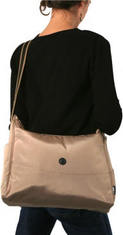 Other key features of the purse are the intelligent ways the pockets are designed so that the direction in which the main zipper opens is the opposite of the way in which the security pockets within open. In other words, if a thief manages to open your purse (which is unlikely since the main zipper has a small hook on the end that needs to be detached in order to open), he/she has to reach all the way across the purse in order to then open the internal pockets. Add to that a pocket that blocks RFID readers and you’ve got a portable safe on your hands. Neda would usually carry the bag for everyday use, but if we felt we were in a dodgy area or on travel days when we were more exposed, I could carry the bag on my front with my arm on top and it would be near impossible for a thief to access. So there you have it - all the essential travel gear we used for keeping our money and valuables safe. Let us know how it works for you if you use any of it. In part 2, we’ll discuss the best electronics for the savvy traveler. See you there! Over the last two years we’ve taken 26 flights, of which 18 charge for checking baggage over 10kg (for some as low as 7kg). Yet with careful planning and a bit of bravado, we never paid for a single checked bag on our trip around the world. We’ve gone back and looked at each airline’s baggage fees and calculated that by not checking bags, we saved $1,182. That’s a lot of sushi rolls, plates of Pad Thai, or bowls of curry! So what’s the secret to spending money on YOUR travel and not the travel of your bags? 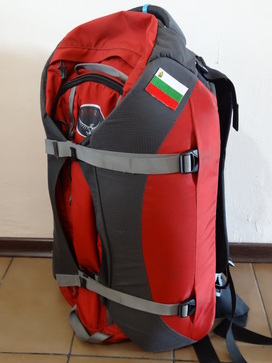 Neda's Porter still looks good after 2 years! Neda's Porter still looks good after 2 years! The Bag – Your Life in 22” x 14” x 9” Nylon Shell The first step is getting the perfect luggage for a traveling vagabond. For us the research distilled down to the Osprey Porter, an amazing travel pack for several reasons. Firstly, it is the exact dimensions for carry-on luggage around the world. To help with making sure the pack fits into the little metal measuring cage the airline check-in staff sometimes make you put it in, the Porter is equipped with two compression straps. The straps have two settings for either mild compression or for full compression. We found that when “fully compressed” we could not only fit the bags into any plane, but often just threw them overhead onto buses as well. This was particularly nice in places like India where we had our packs inside the bus while other travelers had to tie their packs onto the roof! The Porter can easily serve as a weekend duffle because the shoulder straps hide behind a back panel. For our purposes, we almost always carried it on the back, and found the straps to be amply comfortable for up to about an hour or so of walking. This isn’t the ideal pack if you plan on walking the Camino de Santiago, but for walking around town to find your hotel, it’s no problem and its smaller size encourages you to take less in the first place! Still, we found the spacious main compartment large enough to fit all of our travel gear, with some deliberate planning. 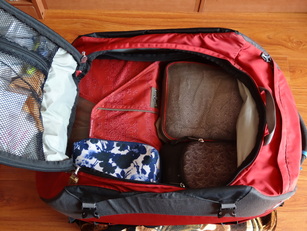 Our Pack Set-Up Our Pack Set-Up Become a Packrat A good packing system perfectly complements the layout of the Porter and will have you breezing through airports. We used one folder and one half cube of the Eagle Creek “Pack-It” system. The folders vary in size (we used the 15” inch size for Neda, who is a fairly small girl, and the 18” size for Jeff who is 6’2”), and neatly fit jeans, shirts, sweaters, and the like. The cube fits all the small stuff like underwear and socks. On top of the cube there was room to put a small zipping bag (my mom had gotten it from a make-up promotion) where we kept computer charger, phone charger, and other small electronic stuff. Next to the half-cube we put a deluxe size REI toiletry bag. While it looks like that isn’t available on their website any longer, this one http://www.rei.com/product/834727/rei-grande-shower-kit, seems similar. Once you’ve got all that in your pack, there is still room to put a pair of sandals and a pair of Vibram Five Fingers, which were a perfect travel sized athletic shoe. We could run, snorkel, and hike in the five fingers all while carrying around only 14oz of weight for Jeff and 7.5oz for Neda! Finally, on top of the shoes we squeezed our Osprey Daylight Daypack, which we used for our day hikes and trips around the cities. The pack is supposed to be able to “add-on” to the back of other larger Osprey packs, but we found that for the porter we could just stuff it in on top of everything else and it would work just fine. We only used one daypack as Neda usually carried a pursue with more secure things inside. To recap, if you want to be an “ultra-lite” traveler, there isn’t room for many extras. My wardrobe while traveling consisted of 5 shirts (one of which doubled as a workout T and backup when everything else was dirty), one pair of shorts, one pair of jeans, a fleece (for cold weather destinations) and a jacket. It’s not much, but it makes picking your outfit pretty easy! 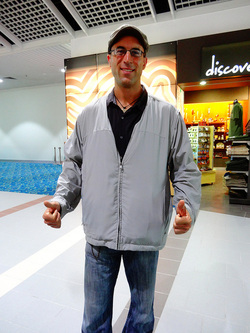 eVest packed to the brim eVest packed to the brim on our way to Tokyo. Making Weight – the Scott Evest We’ve talked above about the size of your luggage, but these days it’s not just the dimensions that have to work to be able to carry-on, it’s the weight as well. Most airlines allowed us 10kg, though on discount carriers that did not include a “personal item.” So the old trick of stuffing the purse wouldn't work. All 10kg have to be in one bag. Some of the worst airlines only allowed 7kg per person! We usually would wear our heaviest clothes like jeans and walking shoes on travel days no matter how hot it was outside. But our secret weapon in making weight was the Scott Evest. The jacket is designed with 20 sturdy pockets that can fit all kinds of things inside. On one side, there is a big pocket where I would put our netbook; on the other side, the bag filled with chargers. 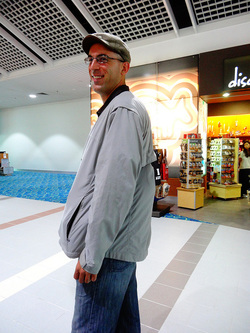 Can you see the sandals in the Can you see the sandals in the pocket on the back? In the back there is an extra pocket where the jacket can fold into itself and become a pillow (great for long bus rides!). But I used it to store my leather sandals, since they weigh a little over a kilo. Other pockets would hold heavier knick-knacks like our travel locks or my electric shaver. With one of those flights that limited us to seven kilos, the travel-vest managed to carry along the other five without being noticed by airline staff! Beyond its usefulness in the airport, I thought the jacket looked pretty snazzy and managed to keep me pretty warm even in chilly environments. It’s an all around great piece of travel gear, though it does come in at a rather steep $135 for the standard version I had. Which brings me to the next point of order…my family got us a bunch of different gifts to support us along our travels and we used all of them, but in the end the travel vest has to win the award for most useful. Thanks Dan for all the research (and cash) you put into it. You were with us in spirit the whole time! 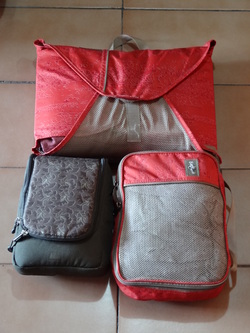 All of our clothes and toiletries All of our clothes and toiletries Psychological Warfare – Passing the various checkpoints and getting onto the plane O.k., so you’ve got all your fancy gear and you’re packed up and ready to go. Only with the extra souvenirs you bought, you realize that your pack is 12 kilos even with the E-vest loaded to the brim! What to do? It’s happened to us a few times and here were our strategies for getting through the airport: * Wear layers – I would wear a shirt, the fleece, and the evest to keep the pack’s profile down. Not the most comfortable, but sometimes necessary * Do a “counter drop” – when Neda & I would walk up to the counter to check in, she would let her purse drop to the floor and I would be carrying the daypack (with the extra weight in it) in my hand and also drop it. Usually the staff don’t see the bag since it’s not in their line of sight. Then, when they ask us to put the bags on the scale to be weighed we can make weight. 90% of the time the only weight check is at that counter, so if you can do a successful counter drop even when you know you are over weight, you’ll have a good chance of getting through. It's a bit sneaky, but so is charging us 30 euros for an extra two kilos! * Wear the packs on your back – you’ll probably do this anyway, but we found that when most airline staff glanced at the packs they never even asked us to weigh them – they look more like school backpacks than luggage! * Be ready for other checkpoints – a few times I took my fleece and jacket off and carried the computer in my hand since it can get hot to wear all that stuff. Once, right before security, they did another weight check. Luckily the computer was hidden under the fleece so it looked like I was only holding my jacket (which they don't make you weight) because I only passed that check by .3 kilos! Lighten Up So there you have it folks – the gear and the strategy for saying goodbye to airline baggage fees forever. If you hadn’t noticed, it does require a certain commitment to the ultra-lite traveling lifestyle. Simply bring less stuff when you travel and make everything you have count. The longer we traveled, the more grateful we were for that decision and with each leg we found we brought less and less. It’s liberating to be able to fit everything into such a small space and gives you so much flexibility when riding buses, taking taxis, and walking around town. Though we used this gear for world travel, we are committed to using it whenever we travel from here on out. So get to it and have a great time! Happy trails! |